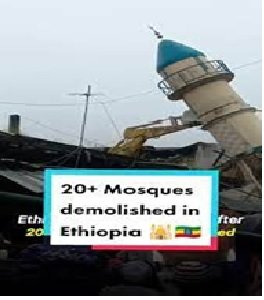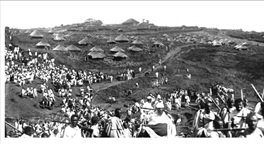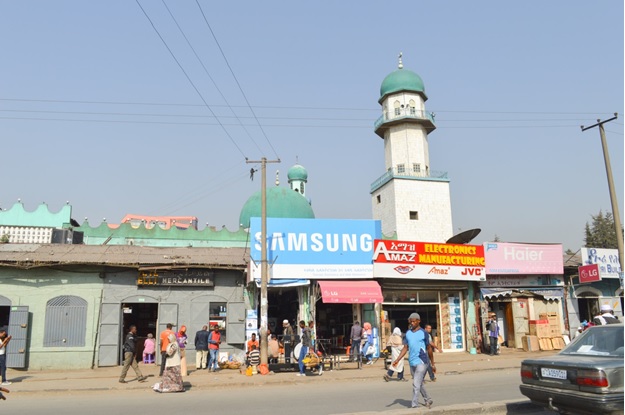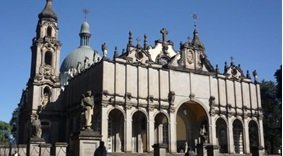By Faisal A. Roble
History of Mosques in Addis Ababa
What is known as Addis Ababa to many is Finfine to the Oromo. A city with a deep historical inequity, Addis Ababa is a contested urban space between new settlers and its indigenous people. Addis Ababa is a quintessential urban space where always a new comer, political other otherwise, seeks to erase the past history in the name of development and modernization.

The current struggle over land in Addis Ababa under the guise of modernizing Addis Ababa is largely land grabbing for “the highest and best use rather than for the actual use value” such as mosques, churches, or other cultural centers. Both the controversial master plan under EPRDF which arguably threatened the values of Oromo farmers adjacent to Addis Ababa, and the current impactful creation of Sheger city, which ended up demolishing over 20 mosques is but the result of faulty urban renewal that is in disarray. Notwithstanding Muslims contribution to the founding of the city, the demolition of over 20 mosques in the span of a few weeks is a historical travesty and an indictment of the ruling Prosperity Party (PP).
Before we proceed, we need to address social justice as it pertains to Addis Ababa. Land ownership and justice go hand in hand. In the interest of restorative justice, one has to recognize and honor the original owners of the land we all are standing on and/or fighting over. It is the land of the Tulama Oromo clans. Restorative justice demands that indigenous people whose land we all have settled, built on houses and institutions without even bothering to ask them, but instead expropriating and exploiting their resources, must be recognized. Therefore, any discussion about contemporary politics and land/urban development in Addis Ababa must underscore and equally lend recognition to the original Oromo Tulama clans like Abbichu, Eekka, Galan, and Gullala.
Similarly, both residents of the city, including international staff – AU, UN, and the diplomatic community – including those passengers passing through it as transit travelers need to equally honor those whom we collectively displaced through modern urban settlements. We all are standing or building on unmarked graves of people, religious shrines, and cultural symbols for whom no one speaks.
Brief History of Addis Ababa
Founded initially as a resort area by emperor Minelli II in 1896, what was a Tulama Oromo farming and grazing land, hitherto known by its local name of Finfina, became Addis Ababa or the “new flower” with emperor Minelli II settling there. The green terrain conducive to solitude lifestyle and resort-like ambiance soon became home to the Shawa aristocracy. Once Emperor Minelli II moved his political seat from the Abyssinian center to the southern belt of Oromia, and with the death of Tigray’s Yohan’s towards the end of the 19th century and the end of the Adwa war, Addis Ababa quickly became a fledgling commercial center and the political seat of the Abyssinian empire.

Following Menellik II’s victory over Italy at Adwa, one of the most important Italo-Abyssinian subsequent treaties that abrogated the Wichale treaty was signed in the new capital of Addis Ababa (Keller, 1988). As peace was restored, the new city attracted more people from different regions of the empire. By 1889, the population grew to 15,000 residents. More subdivisions of land for the burgeoning urban population were authorized; hence more farming land was lost by the Tulama clans.
Accordingly, the first legal subdivision maps or cadastral maps were issued to anyone seeking land development. Subsequently, land speculation in the new city increased with the coming of the Djibouti-Addis rail in 1917, which helped boost immigration, thus injecting talent and capital hitherto not available to Addis Ababa. Muslims, in particular Arab and Indian Muslims traders, moved to the city as early as its founding days. By 1900, a noticeable Muslim community claimed Addis Ababa as its home.

In emperor Menelik II’s era or thereafter, Christianity remained the official religion, and this norm took foothold in the governance of the country. As a result, the Church owns titles of many subdivisions inside and outside Addis Ababa, including regions like the Somali region with 100% Muslim population; it also manages lucrative enterprises. Prior to the Dergu nationalizing rural land, the Orthodox Tewahedo Church (OTC) owned up to 20% of Ethiopia’s cultivable land.
That is not the case with mosques. There are no records to show mosques in Addis hold any significant number of properties, land or otherwise. In most, if not all, cases, mosques unlike churches, buy the lands they develop, inside or outside Addis Ababa. Whereas there are close to 600 churches in Addis alone, less than hundred largely small mosques located in Addis Ababa’s ghettos have been so far documented in the 130-year life of the City.

Muslims have always complained about their “second class citizen” status in a country where they are most probably the single majority religious group. The highlight of such downgraded citizenship for Muslims is expressed in the conversion of Sheikh Bazikh Mosque to the Medanialam Church by the late king Haile Selassie. Again, this is how Ethiopia both in the past and now erases Muslim history and a total denial of that community’s existence. Full and equal citizens for Muslims in Ethiopia are yet to be achieved. Therefore, the demolition of over 20 mosques and the desecration of the religious symbols inside these properties have shocked the world. At minimum, leaders in Addis Ababa did not respect the religious symbols of Muslims.
Mosques in Addis Ababa
With their multi-colored iconic minarets, mosques have been part of Addis Ababa’s landscape. Constructed by an Indian Muslim, the first mosque in Addis Ababa, Wale Mohamed in Awara area, was built in 1898, only two years after emperor Menelik founded the city. That Indian Muslim, who is credited to have constructed Wale Mohamed, is also the same architect who designed and built Menelik II’s palace in the first years of the founding of the city of Addis Ababa.” (Abdulfatah Abdallah, 2008).
According to Abdulfatah Abdallah’s authoritative account, a second mosque, Al-Nur, was built in 1896 during Empress Zawditu. Subsequently, Anwer Mosque in Markato was built in 1922 as Muslim population coming from Harar, Jimma, Gurage, Walo, and other regions adopted the new city as their home
Thriving during the reign of EPRDF, over 100 mosques were built after 1991. This is partly so because Muslims in general felt freer to build mosques due to the newly found openness and the acceptance to diversity by the ruling authority. Since then, smelling Somali incense coming from mosques, or rubbing shoulders with Jalabia wearing families on their way to a Muslim cuisine, or meeting an Arsi mother returning from Mecca is as common to Addis Ababa as are priests going to a Pentecostal or to a TOC. That is precisely why Jane Jacobs says “cities have the capability of providing something for everybody, only because they are created by everybody (Jacobs, 1961). Muslims have helped created Addis Ababa and as such their Mosques need to be respected and protected.
The story of emperor Menelik II and the Muslim architect who capitalized on their relationship to open doors for Muslims reminds students of urban planning the story of Abbot Kinney and the Black craftsman, Arthur L. Rees in the development of the Venice Beach neighborhood in Los Angeles. Abbot Kinney in 1920, designer of one of the most iconic neighborhoods, entrusted a Black craftsman, Mr. Arthur L. Rees, to do all the craftsmanship for the houses in this beach community in the heart of Los Angeles.
As one of the most influential architects in the United States, Abbot Kinney and Arthur L. Rees recreated a replica of Venice, Italy inside Los Angeles. To this day, the Black community that migrated to follow their man, Arthur L. Rees, lives in Venice with freedom and respect. But that is not true for the Muslims who are the first settlers of Addis Ababa. We will briefly look at why it is so, but let us remind ourselves about what cities are supposed to be in general.
Cities are believed to always bring together different people with diverse cultures, religions, and different ways of life. By nature, cities are supposed to be democratic spaces where social justice grows as representative politics and democratization takes roots (Harvey, 1973). The more diverse and mosaic a city is, the more it needs the rule of law, thereby ceding citizen’s autonomy to a legitimate government. In return, citizens expect the government to be tolerant respectful to landmarks and houses of worship. Jane Jacobs, one of America’s preeminent urbanists, says this: “cities were made great by having buildings with different purposes encouraging lively activity throughout the day among neighbors.” Mosques are spaces where lively activities are carried out by worshipers who live and pay taxes in the city.
Why, then, the Prosperity Party-led government of Ethiopia on short notice felt intolerable and marshalled the urge to demolish in weeks about 20 mosques, killed a number of citizens who objected to the government’s draconian measures, and offended millions of Muslims around the globe?
Is this Muslim Hatred or Bad Planning?
Oromumaa and Islam
Resulting in the death of about four people, the first mass protests over the demolition of about 20 mosques in Addis Ababa took place on May 23, 2023. According to Addisstandard, three of the four people who were buried (Zebur Mudesir, Anwar Surur and Ibrahim Denbel) were shot after the Juma’ prayer was finished at the Grand Anwar Mosque.
Although complaints about mosque demolitions in Addis Ababa caused a worldwide outcry against Addis Ababa, the Ulima leadership handled the matter responsibly. Among those who registered official complaints with Prime Minister Abiy Ahmed include the Ethiopian Islamic Affairs Supreme Council and the Oromia Region Islamic Affairs Council. Also, prominent leaders who expressed their dismay to the Ethiopian authority include Ahmedin Jebel and Bedru Hussein with 1 million and 400,000 social media followers, respectively.
The outcry reached the corridors of the White House. In addition to Oromo American Muslims who held a peaceful rally in Minneapolis, the influential CAIR urged the Biden Administration to take measures on the account of the Ethiopian regime demolishing mosques with impunity. On June 9, Ethiopian Muslims in the Washington DC area have also called demonstration in front of the maligned Ethiopian Embassy in that city. Ana Gomez of the EU twitted CAIR’s letter to let Addis Ababa know of her position on the matter of mosques. It is also reported that Turkey, which supplied drones to Prime Minister Abiy to win the war in Tigray, and the United Arab Emirates who bankrolled him, have all sent letters of concern to Addis Ababa.
On the government’s side, both Prime Minister Abiy Ahmed and President Shimeles dismissed the Muslim complaints as hyperbolic and empty cries coming from anti-peace forces. Often callous, the President of the Somali region, known to unnecessarily invalidate legitimate political grievances of social groups that are at odds with the government, equated this historical demolition of mosques and the murder of four Muslim protestors as “isolated incident.”
Other opportunistic voices, however, joined the fray, only to paint the issue as an Oromo versus Muslim problem. Let us set the record straight: unlike what some are preaching in print and on social media, neither Prime Minister Abiy Ahmed nor President Shimeles Abdisa hate Muslims. There are no facts to support such allegations. After all, about 75% of Oromo are Muslims. Without solid evidence, these biased critics blame what the PP administration did on what they pejoratively call “Oromummaa” ideology. Their thesis is that “Oromummaa is an extreme Oromo ultra-nationalism and Oromo political activists hate all Ethiopians, including Muslims. Some even go far enough to call “Oromummaa a racist project.”
In what amounts to be an anger-laden piece blogged by Yonas Biru (PhD), who claims to have blood relations with the late Emperor Haile Selassie, the King of Kings, and the Lion of Judah, for example, he argues that the mosque issue is an expression of “Oromummaa hate” towards Islam. His only proof of this allegation is the following reference he took from Asafa Jalata’s work: “Professor Jalata’s position is that Christianity and Islam ‘need to adapt to national “Oromummaa.” The same criticism against “Oromummaa” also recently came from multiple pan-Ethiopian nationalists.
Unfortunately, these forces have misrepresented the work of Professor Jalata. Professor Jalata has an impressive scholarly work and cannot be discredits by those with insidious intent. The professor is one of handful Oromo scholars who have immensely contributed to the reconstruction of Oromo history and his or other’s work cannot be equated to hating Muslims.
For those of us who are familiar with African Studies Area, Professor Asefa Jalata’s effort to align Christianity or Islam with Oromo tradition is not an affront to what Yonus Biru calls “Abrahamic religions.” To understand more of this and get a full picture of Professor Jalata’s point of view on the intersectionality between Oromo tradition and Abrahamic religions, one has to revisit Ali Mazrui’s “The Africans: A Triple Heritage.” Himself a Muslim scholar from the Swahili community which shares tradition with Somalis and an accomplished student of African Studies Area, Mazrui positively states that Somalis and Yoruba Muslims successfully adopted Islam to their norm and culture. Unless he himself denounces the undeniable contribution of both religions to the making of the Oromo nation, one can argue that Asafa Jalata’s thesis is aligning religion with Oromo tradition consistent with Ali Mazrui’s thesis.
Having said that, and despite the burden imposed on “Oromummaa” by the bad policies cared by PP leaders whom some view as Oromo leaders, no individual can take Islam out of the Oromo, or the Oromo out of Islam. Certainly, Professor Asafa Jalata did not do what some are circulating through social media. Irrespective of faulty policies by some Oromo leaders, the Oromo nation is one of the largest Muslim communities in the Horn of Africa and would remain so.
Alignment of Islam and African tradition is also observed among Somalis. In the early days of Islam penetration into the Somali peninsula in the 9th and 10th centuries, for example, Sheikh Aw Barkhadle translated the Arabic alphabet and what amounts to its vowels to Somali phonetics with Somali haraka or vowels such as: Alif wax male’ Ba’ kor ku hale, Ta’ hoos ku laba leh, Sa’ sadex kor ku sadex leh! That effort strengthened Islam in the Somali society.
Giving “Oromummaa” a pejorative interpretation by pan-Ethiopian ideology, who until recently were praising Prime Minister Abiy, is not congruent with the problems faced by Muslims in Addis Ababa. Muslims are not blaming the Oromo community, nor should they. After all, Prime Minister Abiy is from Jimma Aba Jifar, one of the strong hold of Islam in Ethiopia. Rather, the most reasonable approach to explain the demolition of over 20 mosques by Oromia authority must hinge on policy analysis.
Urban Renewal: Culprit in the Demolition
I argue that Addis Ababa is subjected to faulty public policies and the pursuit of an urban renewal program that went awry. To be precise, expanding Sheger sub city at the expense of mosques is untenable. Muslims make up over half of the 120 Ethiopian population and almost 75% of the Oromo. In addition, “Oromummaa” is shaped by Islam than by either the Orthodox or the Evangelical Church. The most memorable contribution to modern “Oromummaa” is the struggle of the 1960s lead by General Waqow Gutu who hails from Bale. General Waqow Gutu received a helping hand from Somalia.
How, then, does the current urban renewal that offends Muslims by gutting down their mosques benefit the Oromo at large? A policy that does not benefit Muslims will not bode well for the greater Oromo people.
In their blind pursuit of aggressive and devastating urban renewal in Addis Ababa, President Shimeles Abdisa, under the guidance of Prime Minister Abiy Ahmed, joined a long list of proponents of urban renewal philosophy that ended up destroying communities. Authorities in the city of Los Angeles, for example, adopted what was called in 1951 “The Banker Hills Redevelopment Project.” That urban Renewal ran amok and rendered thousands of Hispanic people homeless who are still reeling from the devastation of that program. Since then, the issue of homelessness has been a major headache for the City. In the case of Washington DC, an equally impactful urban renewal program was adopted in the early 1950s which displaced many Blacks. As a result, 80% of homeless people today in Washington DC are Blacks whose parents and grandparents were displaced. The impact of such faulty public policies is intergenerational and stays with the victims beyond the first group or generation.
The crisis of Addis Ababa goes back to the initiation of the Sheraton Hotel in 1998, which ended up displacing many residents of different faiths. Sitting on a hilltop with an unimpeded view shed of the city, and comprised of about 230 rooms that serve expatriates, this behemoth paved the way for grandiose projects that did not center the needs of the poor and the essential workers of the city. The city’s typical Gamachu, Fatima, Hassan, or Hailu would be displaced soon or later. That is how Oromo youth felt about the now defunct master plan whose objectives included the horizontal expansion of the city’s perimeter to Oromo land. Also, from 2018 to now, Prime Minister Abiy’s controversial emphasis on building theme parks and other demonstration projects will have a long term impact on the residents of Addis Ababa. The mosque issue is a part of this web of faulty public policy pursued by this administration.
It is safe to argue that the demolition of mosques in Addis Ababa is the crowning of a badly designed urban renewal policy, a model long time discredited by urban planners. Therefore, I see no credible evidence that neither Prime Minister Abiy nor other leaders of the Oromia region hate Muslims. Moreover, likening the mosque issue to Oromo nationalism is disingenuous and a distortion of the issue at hand. After all, both PM Abiy and Shimeles are in war with Oromo Liberation Army (OLA).
The inescapable truth is this: Despite that they both claim to be people of faith, Prime Minister Abiy and President Shimeles have disrespected Muslims in Ethiopia and in the world. How else can anyone rationalize the demolition of over 20 mosques as if they were dirty shacks to be cleared away with bulldozers without any respect to the religious community they serve? Also, like their predecessors, the leaders both at the federal and regional level, Oromo region that is, are pursuing an antiquated model for their urban agenda, whose end product could cause massive displacements of the poor. Finally, the leaders are simply showing behaviors attributed to autocratic rulers in that the voices of the impacted communities are not respected even when their houses of worship are at stake. As if that is not enough, the lazy and juvenile comment uttered by the Somali regional President that the demolition of over 20 mosques is “an isolated incident” smacks at power abuse, ignorance, and servitude to the powerful boss.
Faisal A. Roble
Email: faisalroble19@gmail.com
———–
Faisal Roble, a writer, political analyst and a former Editor-in-Chief of WardheerNews, is mainly interested in the Horn of Africa region. He is currently the Principal Planner for the City of Los Angeles in charge of Master Planning, Economic Development and Project Implementation Division.
_______
References
Jalata, Asafa, Oromia and Ethiopia: State Formation and Ethnonational Conflict 1868-2004, (Trenton, NJ: The Red Sea Press, 2005).
Harvey, David, Social Justice and The City, (The University of Georgia Press, Athens, 1973).
Horowitz, Donald L, Ethnic Groups in Conflict, (University of California Press, Berkeley, 1985).
Jacob, Jane, The Death and Life of Great Cities, (Random House, New York, 1961).
Kantor, Paul, the Dependent City: The Changing Political Economy of Urban America, (Fordham University, New York, 1988).
Keller, Ed, Revolutionary Ethiopia: From Empire to People’s Republic, (Indiana University Press, 199).
Mazrui, Ali, The Africans: A Triple Heritage, 1986, accessed on June 4, 2023; The African Conditions, (Cambridge University Press, 1980).

Leave a Reply